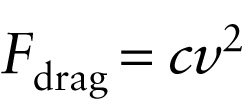Drag force for larger objects at faster speeds (5-9)
Question 1 of 3
Question
Magnitude of the drag force on a larger object moving at a faster speed
{"title":"Magnitude of the drag force on a larger object moving at a faster speed","description":"Correct!","type":"correct","color":"#99CCFF","code":"[{\"shape\":\"poly\",\"coords\":\"82,133\"},{\"shape\":\"rect\",\"coords\":\"3,30,37,76\"}]"} {"title":"Constant that depends on the properties of the object and of the fluid","description":"Wrong","type":"incorrect","color":"#ffcc00","code":"[{\"shape\":\"rect\",\"coords\":\"118,11,119,13\"},{\"shape\":\"rect\",\"coords\":\"167,43,195,81\"}]"} {"title":"Speed of the object relative to the fluid","description":"Incorrect","type":"incorrect","color":"#333300","code":"[{\"shape\":\"rect\",\"coords\":\"197,43,223,81\"}]"}Review
For a larger object moving at a faster speed, such as the sea turtle or skydivers in Figure 5-15, the drag force has a different dependence on the speed v: Its magnitude is approximately proportional to the square of v. In this case, we can write

